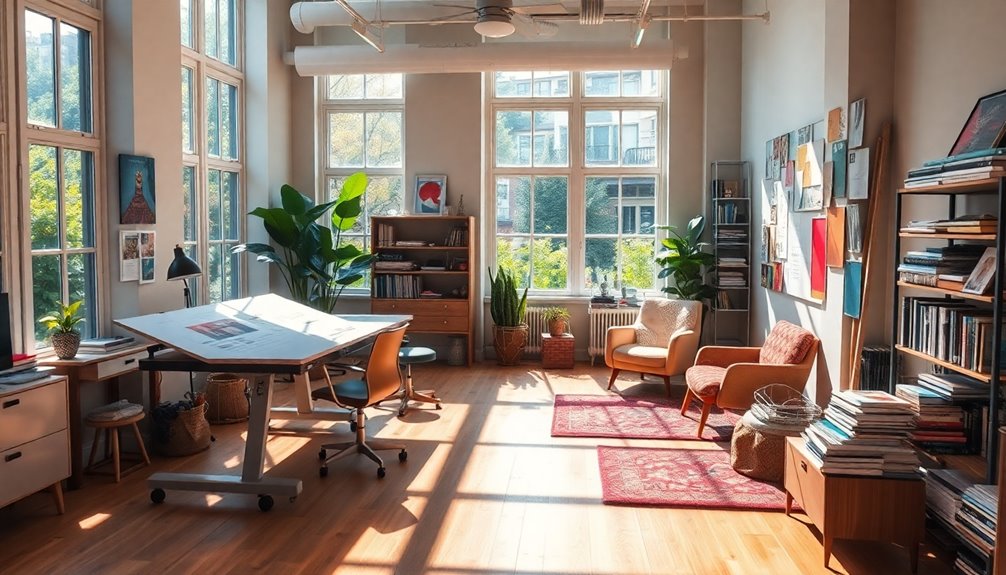A Master's degree in Interior Design can greatly advance your creative career. With specialized programs like the M.A., M.S., or M.F.A., you'll enhance your design skills and open doors to higher positions, like design director or project manager. Most graduates enjoy a salary boost of 20% to 24% compared to bachelor's holders. You'll also benefit from hands-on learning experiences and networking opportunities with industry leaders. Engaging in specialized courses prepares you for niche markets, expanding your potential clientele. Explore how a master's degree can transform your career further.
Key Takeaways
- A Master's degree in Interior Design enhances your qualifications, opening advanced career opportunities such as design director and project manager.
- Specialized courses in sustainable and healthcare design prepare you for niche markets, attracting diverse clientele and projects.
- Completing a Master's program typically results in a salary increase of 20% or more compared to those with only a bachelor's degree.
- Networking opportunities through university connections and alumni networks enrich your career prospects and facilitate mentorship relationships.
- A strong portfolio is crucial for admission, showcasing your design skills and creativity, and enhancing your professional credibility.
Types of Master's Degrees
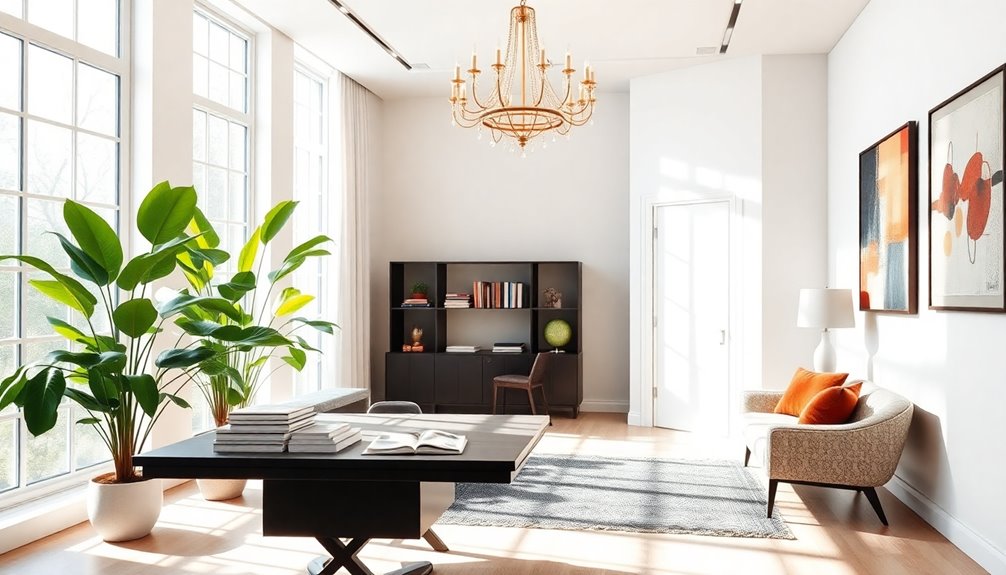
When you consider pursuing a master's degree in interior design, you'll find there are three primary types to choose from: Master of Arts (M.A.), Master of Science (M.S.), and Master of Fine Arts (M.F.A.).
The M.A. focuses on theory and culminates in a portfolio, making it ideal for those seeking a creative approach.
The M.S. emphasizes scientific design analysis and often requires a thesis, attracting those who prefer a research-oriented path.
The M.F.A. represents the highest level of study, involving teaching opportunities and apprenticeships, typically requiring three years to complete.
Each of these types of master's degrees offers unique benefits, allowing you to tailor your education to your career goals in the diverse field of interior design.
Admissions Requirements
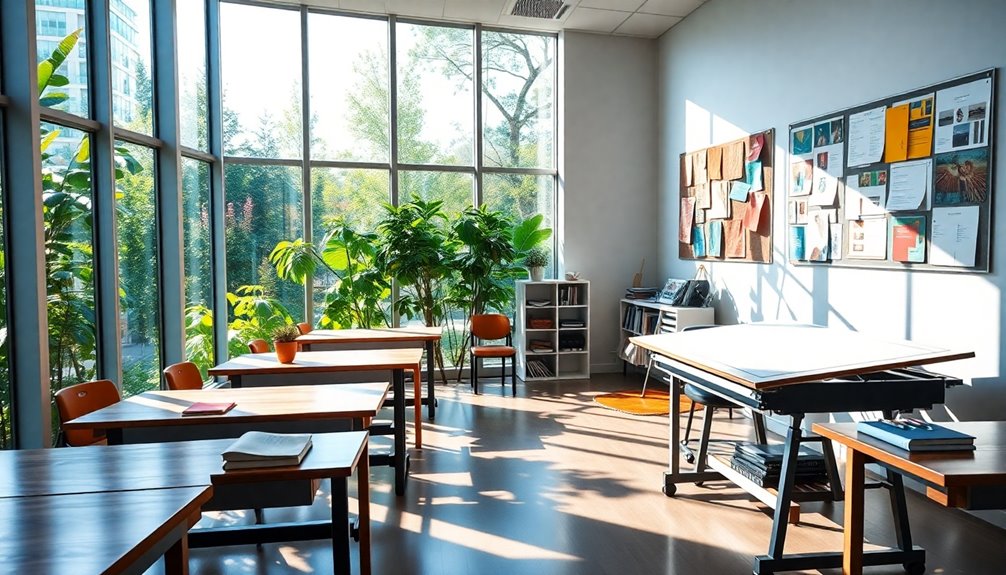
When you're considering a Master's degree in Interior Design, you'll need to meet specific academic qualifications.
A strong portfolio showcasing your design work is essential, along with any required standardized test scores.
Understanding these admissions requirements can help you prepare a competitive application.
Academic Qualifications Needed
To gain admission into a master's program in interior design, you'll typically need a bachelor's degree in interior design, architecture, graphic design, or a related field.
Most graduate programs expect a minimum overall GPA of 3.0, though this can vary by institution. Additionally, some programs require standardized test scores like the GRE.
You'll also need to submit a personal statement outlining your motivations and goals in the field of interior design.
While many master's programs offer both full-time and part-time study options, most degrees take two to three years to complete, depending on your background.
Meeting these academic qualifications is essential for advancing your career in this creative industry.
Portfolio Submission Importance
A compelling portfolio is essential for securing admission to a master's program in interior design. Your portfolio submission showcases your design skills, creativity, and understanding of the field, making it a critical component of the admissions process.
Typically, it should include 8-15 diverse projects that highlight your technical proficiency, conceptual development, and unique style. These might consist of sketches, CAD drawings, and completed works that reflect your range and depth of experience.
A well-organized and visually appealing portfolio not only enhances your chances of admission but also demonstrates your professionalism and commitment to the discipline.
Be sure to review any specific guidelines provided by the programs you're applying to, as adhering to these can set you apart from other candidates.
Standardized Test Requirements
Are standardized test scores a necessity for your interior design master's application? Many programs do require them, like the GRE, as part of their admissions criteria.
However, these requirements can vary by institution, so it's important to check individual program guidelines.
You might find that some programs will waive standardized test scores if you have:
- A strong academic background
- Relevant professional experience
- Competitive scores in other areas of your application
A solid score can definitely enhance your chances of admission, especially for programs with limited enrollment.
To guarantee you meet or exceed the minimum requirements set by your chosen programs, it's advisable to prepare for these tests well in advance.
Program Duration
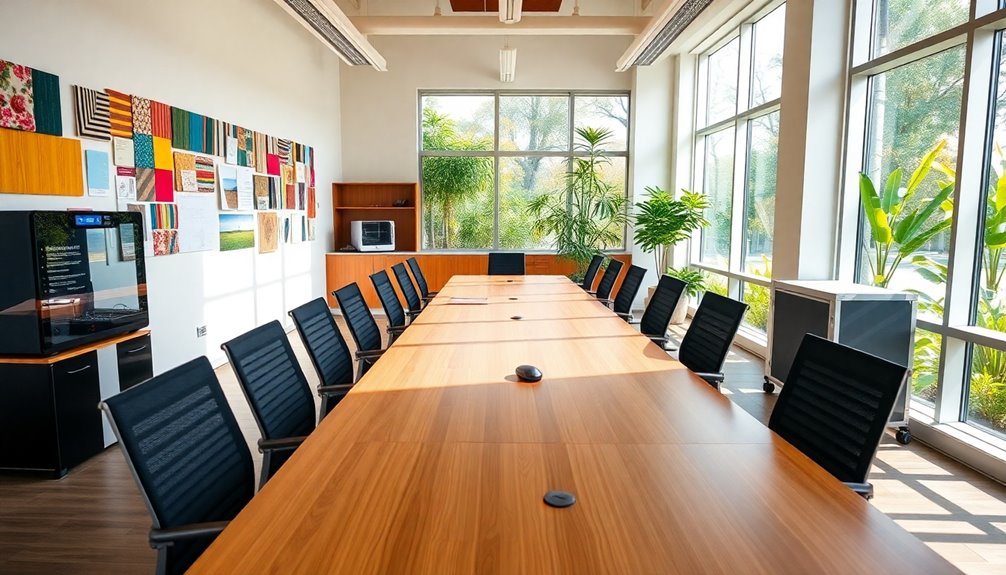
When you consider pursuing a master's degree in interior design, you'll find that program durations typically range from two to three years.
If you're studying full-time, you can expect to finish quicker than if you choose a part-time schedule.
Keep in mind that your undergraduate background might also affect how long it takes to complete your degree.
Typical Program Length
Most Master's degree programs in interior design take about two to three years to complete, depending on factors like your enrollment status and the specific program format. Understanding the typical program length helps you plan your graduate studies effectively.
Here are some key points to evaluate:
- Master of Arts (M.A.) and Master of Science (M.S.) programs usually require around two years of full-time study.
- Master of Fine Arts (M.F.A.) programs often extend to three years due to advanced coursework.
- Working professionals may benefit from programs offering evening and weekend classes, allowing for a better balance between education and job responsibilities.
If you have an unrelated undergraduate degree, you might need a three-year track to cover foundational coursework before diving into your master's program.
Full-Time Vs Part-Time
Choosing between full-time and part-time enrollment in a master's degree program in interior design can greatly influence your educational journey.
Full-time programs typically take two years to complete, allowing you to dive deep into projects and coursework while accelerating your skills development. This immersive experience can lead to more hands-on opportunities in the interior design industry.
On the other hand, part-time programs extend to three years or more, offering flexibility for those juggling work or other commitments. Evening and weekend classes accommodate your busy schedule but may slow down your networking opportunities.
Ultimately, your decision should reflect your personal goals, lifestyle, and how quickly you want to advance in the competitive interior design field.
Curriculum Overview
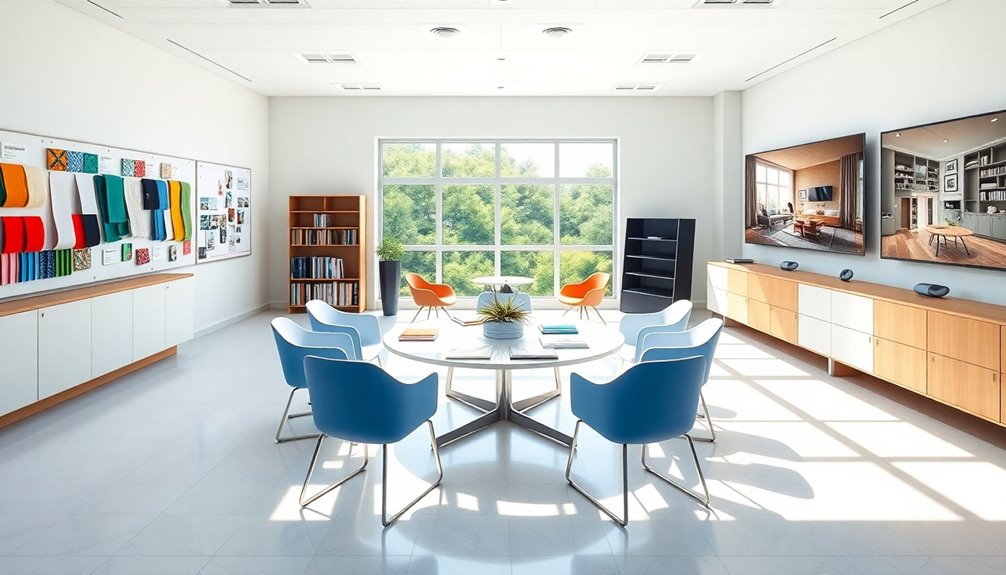
As you explore the curriculum for a Master's in Interior Design, you'll find a well-rounded blend of theoretical knowledge and practical skills. The program emphasizes core areas essential for your growth in the field, such as:
- Advanced design principles: Investigate color theory and spatial planning.
- Project management: Learn to oversee design projects from concept to completion.
- Technical skills: Gain proficiency in design analysis, drafting, and software applications.
You'll engage in studio courses and capstone projects, applying your knowledge to real-world challenges.
Additionally, specialized courses in areas like healthcare and sustainable design prepare you for niche markets.
This thorough curriculum equips you with the tools needed to succeed in a dynamic interior design career.
Environmental Psychology
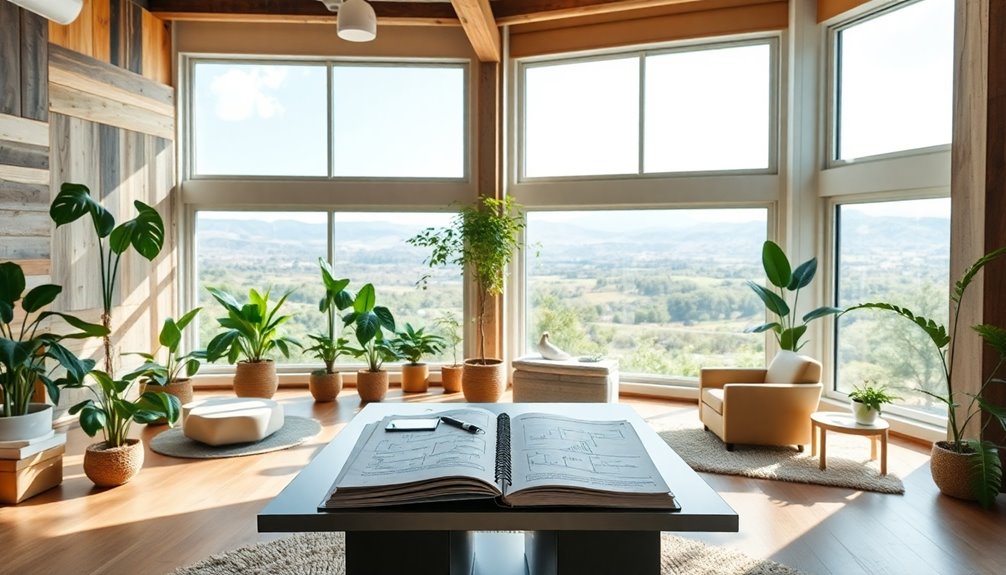
Understanding environmental psychology helps you grasp how human behavior interacts with different spaces.
You'll see how design choices, like lighting and color, can directly impact mood and productivity. Additionally, incorporating design thinking principles can enhance your ability to create environments that foster well-being and creativity.
Human Behavior Insights
Human behavior is intricately linked to our physical environments, and that's where environmental psychology comes into play. By understanding human behavior insights, you can utilize design elements to create spaces that foster well-being.
Here are three key considerations:
- Natural Light: Maximizing daylight can boost mood and productivity.
- Room Shape: The layout influences interaction and comfort levels.
- Biophilic Design: Integrating nature into interiors reduces stress and enhances cognitive function.
These strategies not only enhance aesthetics but also improve overall experiences in both residential and commercial spaces.
Design Impact on Mood
The design of a space can profoundly affect your mood and overall well-being. Environmental psychology shows that elements like color, lighting, and arrangement play a vital role in shaping your emotions. For instance, warm colors evoke comfort, while cool shades promote tranquility. Here's a quick look at design elements that impact mood:
| Design Element | Mood Influence | Example |
|---|---|---|
| Color | Warmth vs. Calmness | Reds vs. Blues |
| Lighting | Stress Reduction | Natural light exposure |
| Spatial Arrangement | Productivity Enhancement | Open vs. cluttered spaces |
| Biophilic Design | Improved Mental Health | Indoor plants |
| Design Software | Visualization of Concepts | 3D modeling tools |
As an aspiring interior designer, using these insights can help you create spaces that elevate well-being. Additionally, incorporating biophilic design elements like indoor plants can further enhance mental health and create a more soothing environment.
Career Opportunities
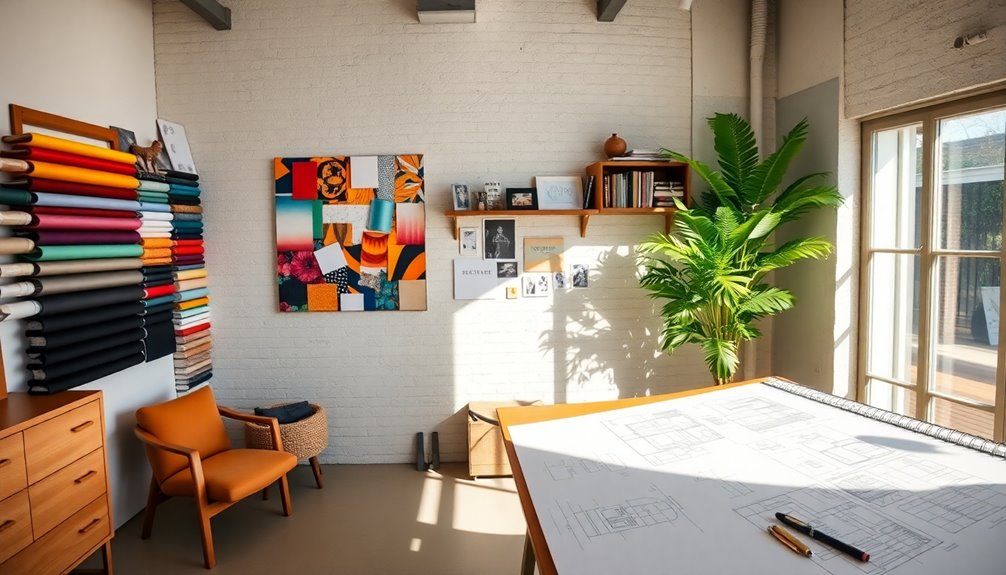
Pursuing a Master's degree in Interior Design opens up a world of career opportunities that can greatly elevate your professional path. With advanced roles like design director or project manager, you'll notably enhance your influence in design projects.
Consider the potential career avenues:
- Enter niche markets, such as healthcare or sustainable design, making you more attractive to clients.
- Explore academia, teaching at universities and shaping future designers.
- Benefit from a projected 4% growth in employment, ensuring steady demand for skilled professionals.
Moreover, Master's degree holders often see salaries increase by 20% or more compared to those with just a bachelor's, solidifying your financial prospects in various interior design careers.
Your skills for interior design will be invaluable as you advance. Additionally, a strong understanding of sustainable materials can set you apart in the growing field of eco-conscious design.
Skills Development
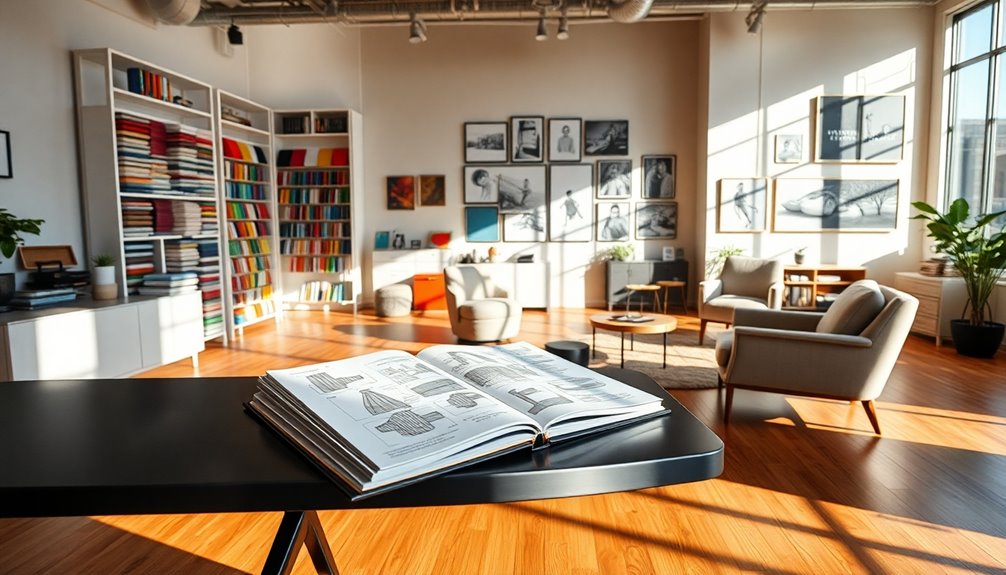
While earning your Master's degree in Interior Design, you'll sharpen essential skills that directly impact your design practice.
The curriculum emphasizes advanced design techniques and methodologies, enhancing your technical skills in industry-standard design software. You'll engage in hands-on learning through studio courses and capstone projects, which foster critical thinking and problem-solving abilities necessary for tackling complex design challenges.
Exposure to cutting-edge technology will prepare you for the evolving demands of the field. As you explore diverse design theories, you'll encourage innovation and creativity, equipping yourself to confidently address sophisticated design problems.
Networking Benefits

As you develop your skills in interior design, you'll find that building a strong professional network is just as important for your career. A master's program offers invaluable networking opportunities that can greatly impact your future.
- Access exclusive job postings and internships through university connections.
- Gain insights from industry leaders during guest lectures and workshops.
- Enhance your professional setting by joining organizations and alumni networks.
These connections not only enrich your learning experience but also promote career advancement.
Building relationships can lead to mentorship opportunities, opening doors to collaborative projects and job offers.
Teaching Opportunities

A master's degree in interior design opens the door to exciting teaching opportunities at the collegiate level, where you can inspire and shape the next generation of designers.
Academic institutions often require advanced degrees for faculty positions, making your graduate education invaluable. By sharing your expertise and practical experiences, you'll influence aspiring designers and foster a community of practice that enhances the educational landscape.
Teaching not only allows for professional engagement in academia but also offers a platform for contributing to research and design advancements.
Additionally, you can balance your design practice with mentorship, enriching your career while guiding students on their journeys.
Embrace these rewarding opportunities to elevate both your profession and the future of interior design.
Financial Benefits

Pursuing a master's degree in interior design not only enhances your skills but also considerably boosts your earning potential. Graduates can earn 20% to 24% more than those with just a bachelor's degree.
The financial benefits of advanced education are significant:
- Median annual salary for interior designers is around $62,510, but can reach $73,990 in top industries.
- Higher-level roles, like design director or project manager, typically come with increased salaries.
- Specialized knowledge attracts larger projects and higher-profile clients, enhancing income possibilities.
With approximately 9,000 job openings projected annually through 2032, your master's degree positions you for lucrative opportunities, making it a smart investment for your creative career.
Frequently Asked Questions
Is Interior Design a Creative Career?
Yes, interior design is definitely a creative career.
You blend artistic vision with practical functionality to craft beautiful and livable spaces. With a focus on aesthetics and usability, you get to express your creativity while solving real-world problems.
The field encourages innovation, and each project allows you to explore new ideas and styles. As trends change, your ability to adapt and create unique environments keeps your work fresh and engaging.
Is It Worth Getting a Masters in Interior Design?
Deciding if it's worth getting a master's in interior design depends on your career goals.
If you're aiming for specialized roles or want to increase your earning potential, a master's can be beneficial. You'll gain advanced skills and knowledge, allowing you to tackle complex projects.
Plus, you'll connect with industry leaders, opening doors for collaboration and job opportunities.
In a growing field, an advanced degree could give you a competitive edge.
What Are the Career Advancement Options for Interior Designers?
As an interior designer, you've got several career advancement options.
You can pursue leadership roles like design director or project manager, where you can steer major projects.
Specializing in areas like sustainable design or healthcare can boost your marketability.
Networking through industry events opens doors to exclusive job opportunities.
Additionally, you might consider teaching in higher education, allowing you to share your expertise while further developing your own design practice.
What Masters Can I Do With an Interior Design Degree?
Imagine transforming spaces that inspire and uplift.
With your interior design degree, you can pursue a Master of Arts (M.A.) for creative projects or a Master of Science (M.S.) that hones your technical skills.
If you're passionate about teaching or advanced artistic practice, consider a Master of Fine Arts (M.F.A.).
Specialized programs in sustainable or healthcare design could also enhance your expertise, opening doors to exciting career opportunities and higher earnings.
Conclusion
So, are you ready to take your creative career to the next level? Pursuing a master's degree in interior design opens doors you never knew existed. You'll gain invaluable skills, tap into the fascinating world of environmental psychology, and build a powerful network. But here's the catch: the journey won't always be easy. Are you prepared to face the challenges ahead and transform your passion into a thriving career? The answer could change everything for your future.
